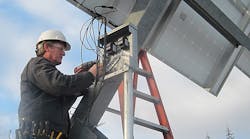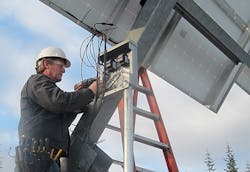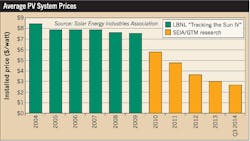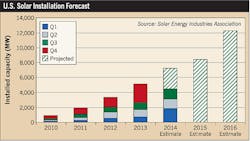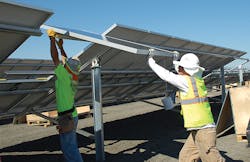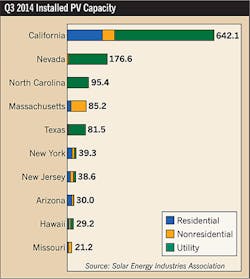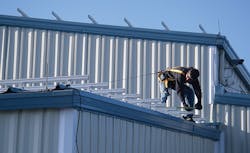Solar installations could reach the 1 million mark in 2015, according to the Solar Electric Industries Association (SEIA). Last year, SEIA found that 36% of new electric generation came from solar, and 143,000 people worked in the industry, which is up 43% since 2012.
As opportunities heat up in this market, electrical contracting firms are training their field workforce to install renewable energy systems nationwide. In some states, journeyman electricians are already qualified to work on photovoltaic projects, but in other regions, they must obtain a specialty license or certification.
In addition, today’s electricians must understand how to work as part of a green building team. As more owners look for ways to conserve energy and cut costs, electricians must not only be familiar with the latest sustainable construction guidelines, but also be able to put them into practice.
“The energy codes are quickly becoming stricter, which is driving increased performance in buildings,” says Ellen Honigstock, director, education development for the Urban Green Council, the New York chapter of the U.S. Green Building Council. “While it’s great for contractors to voluntarily adopt sustainable practices, electricians must also be aware of the direction that stricter energy codes and standards are taking the industry.”
To meet contractors’ and electricians’ demand for training, local union halls, industry associations, independent training companies, and community colleges are offering courses — ranging from one day to a full week to an entire semester. During these training sessions, electricians are not only learning about technologies and work practices in the classroom, but in some cases, they are also able to test their skills out in the field.
Training the trades
To help electricians and other trades handle the transition from conventional to sustainable construction practices, Urban Green Council launched the GPRO training program five years ago.
“Our board realized there wasn’t a lot of green education out there for people working in the trade,” says Honigstock. “Most of the education was on the design side. To build green buildings, however, you need to understand the intent of sustainability from design all the way through operation, which includes everyone working on the project. We saw a gap, and we decided we could fill it by providing a core curriculum for building trades.”
Urban Green Council first focused on completing the construction management and operations/maintenance modules and then launched into the trade-specific courses, including electrical, plumbing, and mechanical. The training courses, which last about 12 hours, are designed to be an overview of sustainable work practices. To ensure the content was useful and relevant for the GPRO Electrical Systems course, Urban Green consulted with local IBEW contractors and electricians instead of solely relying on architects and engineers.
Next, Urban Green Council partnered with Local 3, which became the first IBEW Local to teach GPRO to its apprentices and journeymen. Since January of 2011, about 6,000 individuals have passed the certification exam for GPRO, and more than 800 of the program participants were from Local 3. Throughout all the training sessions, Honigstock says Urban Green Council is not trying to teach the students how to be electricians. Instead, the organization’s mission is to train incumbent workers on sustainable work practices.
The program is set up through a train-the-trainer approach and peer-to-peer teaching model. Rather than having engineers teach the electricians, the courses are taught by expert professionals in the trade. In the course, the instructors focus on lighting, heating, cooling, renewable energy, and work opportunities brought about by green building work (see Shifting from Conventional to Sustainable Work Practices).
“Journeyman electricians often struggle with new practices and technologies through their work in sustainable, high-efficiency buildings,” she says. “But once they have figured it out, they are then able to teach the next generation.”
Before standing up in front of a room full of electricians, however, the journeyman electricians often attend courses at the Electrical Training Alliance’s (formerly NJATC) National Training Institute in Ann Arbor, Mich. For the last 25 years, the institute has offered a five-year program that teaches instructors how to effectively present material to students. At last year’s NTI, Urban Green Council taught a GPRO Instructor Training session to instructors from IBEW locals across the country. Currently, the program has 40 electrical instructors in 22 locals who are qualified to teach GPRO to its members.
During the course, instructors teach the electricians about the subtle differences between green and conventional construction. Oftentimes, project teams that are new to high-performance building make the same mistakes over and over again on green building projects, but through training on sustainability, the instructors can help flatten the learning curve.
“Once they get it, they get it, and when they learn about sustainability, they don’t go back,” Honigstock says.
After taking the class, electricians often understand the reason for sustainability, and they want to go on to take more classes, pursue careers as solar installers, or find ways to incorporate green construction practices into their projects. In many cases, the students often send photos of their work to the Urban Green Council following completion of the course.
“If they are working on a green project, they will come back to us and tell us about how they are doing things like using low VOC sealants or installing solar arrays,” she says. “They are very excited about it.”
While the Urban Green Council started offering training in the New York area, the group is also trying to expand its reach. For example, they recently taught an instructor training course at San Diego Electrical Training Center for IBEW Local 569 and hope to expand to other California locals. The California instructors, having worked with stricter requirements under Title 24, bring a wealth of knowledge and experience.
“We are ramping up, and, eventually, we will get the ball rolling region by region,” she says. “We are very excited, but we have a long way to go.”
Earning a license
Along with completing voluntary training courses, electricians also must follow their state’s rules and regulations before working on the electrical portion of a renewable energy system, like a photovoltaic array. For example, in the state of Oregon, workers who install the electrical portion of a photovoltaic systems must hold either an inside electrician or a limited renewable technician (LRT) license.
“The state of Oregon is very regulated, and if you don’t have an electrical license, you can’t legally work on the electrical portion of a solar PV system,” says Ken Den Ouden, the electrical supervisor and primary project manager for Advanced Energy Systems, a solar photovoltaic and solar thermal design integration company and independent electrical contractor. “I think that helps on quality assurance that systems are installed safely and by the National Electrical Code requirements.”
A number of states have no licensing requirements, which increases the risk factor for rooftop solar installations, he says.
“I think it’s important to have licensing and people who have gone through this training install the systems,” he says. “If you don’t put up a system safely, there can be shock or fire hazards on buildings, and safety issues can come back to cause problems.”
Erik Westerholm, a project specialist in the energy program for the Northwest Water and Energy Education Institute at Lane Community College, says Oregon introduced the LRT program 10 years ago following the renewable energy boom-and-bust cycle as a way to protect the consumers.
“Fly-by-night companies were doing shoddy work like putting up a system and not hooking it up,” he says. “Oregon was trying to avoid this by ensuring that everyone was licensed by the state and a member of the trade.”
With the LRT license, the workers can work on anything up to 25kW on the DC side of the inverter.
“It is not a particularly large license as far as what you can do, but for those who are interested in photovoltaics and renewable energy, it lets them apply their trade,” Westerholm says.
For example, Advanced Energy Systems hired an LRT to work alongside two apprentices and four journeyman electricians on solar photovoltaic projects. To earn his limited license, the employee had to spend 4,000 hours on the job plus complete two years of classroom work. During the program, he learned everything from module installation to wiring of the modules and conduit work on the DC side all the way to the inverter.
About 95% of the company’s business is focused on solar and photovoltaic systems; 75% is commercial work and 25% is residential. Because most of the systems that the workers install are under 30kW, the LRT can work on most of the systems.
To work on the AC side of the system, however, the worker had to go on to earn his inside electrician license. Den Ouden encourages all LRTs to pursue their full license through a separate licensing program because it gives them more flexibility. Westerholm agrees, saying that by gaining a few years of experience as an LRT and then earning a full journeyman license, an electrician can be very marketable in the competitive industry.
“Once they are in the trades with a limited license as a dedicated renewable energy installer, they can jump into a higher license apprenticeship program to become a full journeyman electrician,” Westerholm says. “In Oregon, we are training electricians to be expert installers of PV systems, and both union and non-union programs are doing a good job with preparing them for opportunities in this industry.”
If a journeyman electrician works for a renewable energy firm, he or she often has to receive specific training on wiring and how to calculate solar PV systems to work with inverters and building systems. Advanced Energy Systems ensures that the inside electricians receive rigorous on-the-job training.
“It’s a rarity to find electricians who have a license who have done solar or PV work,” says Den Ouden of Advanced Energy Systems. “It’s a challenge to find that base of skilled workers.”
Compounding the challenge, students often don’t gain an in-depth knowledge about solar or PV during their apprenticeship, and electrical contractors may not offer on-the-job training if they don’t specialize in renewable energy installations. To avoid this issue, Advanced Energy Systems focuses almost entirely on this market and ensures electricians have their “boots on the ground and on the roof,” Den Ouden says.
Electricians can get quality on-the-job training and classroom education through a number of sources, including local community colleges, associations, and apprenticeship programs. Not all training programs are created equal, however, and Westerholm cautions electrical contractors to ensure that a reputable provider is offering the training before making a significant investment.
“When there is a significant demand for something, a lot of people step forward and say that they can offer that, and this is happening with PV training,” Westerholm says. “Some places are just putting any kind of training out there, but it’s not applicable to professional tradespeople. I’ve had people call me and say that they are taking out loans to pay for a certain kind of training from an unaccredited program. That often raises a yellow flag.”
It can be challenging to get PV design, installation, and code-specific education from a trustworthy provider that is familiar with federal and state incentives and how to communicate with a utility, he says. To ensure that contractors and their employees don’t get duped into paying for an unreputable program, he says it’s important for them to perform their due diligence. For example, contractors should connect with other firms that have gone through a similar program, and aspiring installers should try to find former students who have been placed in jobs after graduation.
With the worker shortage and the booming solar PV industry, Westerholm says quality training programs for renewable energy system design and installation are becoming increasingly important.
“The West Coast has been progressive in supporting renewable energy and bringing up a new generation of tradespeople into these jobs,” Westerholm says. “A lot of the electricians, plumbers, and other tradespeople are in their 50s and 60s, and we need to train the next generation. Through a renewable energy apprenticeship, we can put out workers with a state license in an electrical or plumbing field.”
The renewable energy industry offers a wealth of opportunities for electrical contracting firms, depending upon their geographical location and local incentives. While it may not supplant a firm’s entire customer base, it can provide an additional offering for many firms to pursue, Westerholm says. In turn, they can hire electricians from local labor halls or apprenticeship programs with previous education and experience in renewable energy. For example, Westerholm says Local 48 has recently advertised that it has a workforce that is fully trained and ready to tackle photovoltaic jobs.
“I have seen a real enthusiasm about training these installers,” he says. “People are seeing the value of it, and they’re realizing that renewable energy has the opportunity to reduce the impact of conventional energy. There is a tremendous demand for electrical engineers, utility workers, and electricians to help to manage and balance the electrical load.”
Gaining real-world experience
After journeyman electricians and field managers have gained experience in the field of renewable energy, they can then go on to become certified by the North American Board of Certified Energy Practitioners (NABCEP). The certification body offers both an entry-level exam and professional-level certification, depending upon years of experience in the field. Richard Lawrence, executive director of NABCEP, says that either level of certification is appropriate for electricians, but is also applicable for engineers, designers, and sales professionals. Over the last 10 years, NABCEP has certified 2,890 professionals.
Currently, 250 qualified training providers throughout the country are registered to give the entry-level exam, including community colleges, technical schools, and Electrical Training Alliance programs. Before taking the exam, students must first complete about 40 to 60 hours of classroom training on the fundamentals of solar technology and the basics of system design and installation practices. Regardless of where they take the training or the exam, all the instructors will be teaching the same learning objectives, and the courses will all follow the same blueprint, Lawrence says.
“Coming into the course on solar with an electrical background is key,” Lawrence says. “Our certification is designed for those who are installing solar systems, and many of those are licensed electricians and electrical contractors.”
While the entry-level exam covers the fundamentals of the technology and the different components of a PV array, the professional-level certification is designed for licensed electricians and electrical contractors who are able to document that they had a decision-making role on the installation of at least three systems. If a firm is not licensed, then it must document at least five systems that it has worked on. In addition, to secure a professional certification, workers must have completed at least 58 hours of advanced training related to design and installation and carry an OSHA 10 card for safety training.
“The NABCEP certification doesn’t supersede or replace licensing, but is rather an additional way for electrical contractors to demonstrate their photovoltaic knowledge and experience,” he says. “In turn, they can gain a competitive edge on projects. The customers will want to make sure that the people working on their jobs are certified, and our certification verifies that someone knows solar technology.”
The professional certification lasts three years. After that time, the photovoltaic professionals must document continued education and experience. They must have 18 hours of continuing education or six hours a year and a minimum of three systems.
“Both of those are minimum requirements, and we are going to continue to verify that they are continuing to practice and are training in the field,” he says.
In addition to NABCEP, both non-profit and for-profit training companies are offering courses in solar installations. More NJATC training programs and community/technical colleges are also integrating solar training modules into their electrical programs.
“It is more commonplace for it to be part of a basic electrical program, or they are also offering continuing education courses for those already working in the industry,” he says.
Whether electricians learn about sustainable work practices and renewable energy systems during their apprenticeship or from spending years in the field, gaining this knowledge can open doors to new opportunities, Honigstock says. She says due to sustainability, there are more and better jobs for electricians as well as lucrative opportunities for electrical contracting firms.
“We live in an electrified world,” she says. “The opportunities are just enormous, and the folks in the industry are beginning to learn that by aligning their existing skills with the opportunities, they can take advantage of what is out there.”
Fischbach is a freelance writer and editor based in Overland Park, Kansas. She can be reached at [email protected].
SIDEBAR 1: Solar Stats
• Installed photovoltaic capacity posted a 41% year-over-year gain in the third quarter of 2014 with 1,354MW.
• The cumulative installed solar capacity now sits at 17,500MW.
• There were almost 600,000 solar installations in the United States through the third
quarter. This capacity is enough to power more than 3.5 million average American homes.
Source: SEIA/GTM Research “U.S. Solar Market Insight: Q3 2014”
SIDEBAR 2: Shifting from Convention to Sustainable Work Practices
Urban Green Council developed GPRO, a training course specifically for the electrical trade. The class is taught by industry experts using real-life classroom exercises and is suitable for subcontractors, installers, and technicians. Here is what the electricians learn during the 12-hour certification course.
Part 1: Fundamentals of Building Green
• Economic and health benefits of green building
• Causes and impacts of a changing climate
• Transitioning to sustainable construction practices
• Complying with green codes and standards
• Understanding LEED
• Overview of green building strategies
• The importance of commissioning
Part 2: Electrical Systems
• Important sustainability issues for electricians
• Economic opportunities for the electrical industry
• The role of electrical systems within the “whole-building” approach
• The key differences between green and conventional electrical products and work practices
• Improving efficiencies in lighting and HVAC
• New technologies for distributed generation
• Using benchmarking and other tools to maintain building performance
• The electrician’s role in the building commissioning process
• Retrofitting existing buildings with energy-efficient technologies
• Green bidding issues for electricians
SIDEBAR 3: Tips for Electrical Contractors Breaking into Solar
1. Don’t take a cookie cutter approach. Electrical contractors need
to look carefully at the structure and determine the intended purpose for the photovoltaic installation. Firms need to find out if the client is trying to offset consumption or become independent of the grid.
2. Be aware of local codes and net-metering rules. While some utilities will purchase additional energy generated by a PV system, not all of them operate under the same rules and regulations. For that reason, it is important to be vigilant on tracking the latest developments on this front.
3. Make the commitment. The photovoltaic market offers opportunities, but also many challenges to the installing contractors. As such, it is important for electrical contractors to commit fully to training their electricians and being able to effectively handle the work.
SIDEBAR 4: Renewable Resources
• The North American Board of Energy Practitioners offers both entry-level and
professional-level certifications: www.nabcep.org
• The Interstate Renewable Energy Council maintains an online solar licensing database
and details what is required state by state: www.dsireusa.org
• The Urban Green Council offers a GPRO certification for electricians and other installers:
http://gpro.org
• The Solar Map shows the potential for solar in different states nationwide: http://energy.gov/maps/solar-energy-potential
